| Listing 1 - 10 of 10 |
Sort by
|
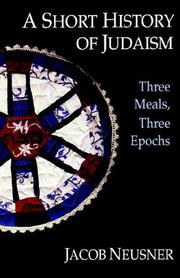
ISBN: 0800625528 Year: 1992 Publisher: Minneapolis Fortress Press
Abstract | Keywords | Export | Availability | Bookmark
 Loading...
Loading...Choose an application
- Reference Manager
- EndNote
- RefWorks (Direct export to RefWorks)
Judaism - History. --- Jews - Intellectual life. --- Judaism - Customs and practices.
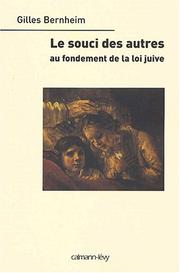
ISBN: 2702133169 9782702133163 Year: 2002 Publisher: Paris : Calmann-Lévy,
Abstract | Keywords | Export | Availability | Bookmark
 Loading...
Loading...Choose an application
- Reference Manager
- EndNote
- RefWorks (Direct export to RefWorks)
" Les lois et les fêtes juives, charpentes de la vie et du temps, sont faites pour aider l'homme à se réaliser dans son humanité et pour favoriser l'humanité d'autrui, ainsi qu'il fut exigé lors de la Révélation du Sinaï : être capable de relation et de transmission. Savoir parler et écouter, donner et recevoir. Savoir regarder. Être en mesure de réparer un préjudice, toutes sortes de préjudices. Donner du temps aux choses et aux rencontres. Somme toute, il ne s'agit peut-être que de tenter d'être à hauteur de quelques verbes, de quelques principes. Inlassablement, la Torah les égrène. De même, fauteur a essayé, à travers cette étude, d'épeler les mots essentiels, ceux des versets bibliques et des rites qui aident à vivre. " Cela passe par une profession de foi clairement affichée : donner à penser à ceux qui sont disposés à entendre, dans les interrogations du judaïsme, une part de ce qu'ils ont à entendre d'eux-mêmes. En ces temps où les religions affichent parfois un troublant repli sur elles-mêmes, il appartenait à l'auteur de montrer clairement que le souci des autres s'inscrit au fondement de la loi juive.
Judaism --- Jewish law --- Fasts and feasts --- Customs and practices --- Religion - Judaism --- Judaism - Customs and practices --- Fasts and feasts - Judaism
Book
ISBN: 2869700148 9782869700147 Year: 1990 Publisher: [s. l.] : Bibliophane Edition,
Abstract | Keywords | Export | Availability | Bookmark
 Loading...
Loading...Choose an application
- Reference Manager
- EndNote
- RefWorks (Direct export to RefWorks)
Judaism --- Fasts and feasts --- Jewish way of life --- Customs and practices --- Judaism - Customs and practices --- Fasts and feasts - Judaism
Book
ISBN: 0465019641 9780465019649 Year: 1987 Publisher: New York
Abstract | Keywords | Export | Availability | Bookmark
 Loading...
Loading...Choose an application
- Reference Manager
- EndNote
- RefWorks (Direct export to RefWorks)
Jewish religion --- Judaism --- Jewish way of life --- Customs and practices --- Meditations --- Judaism - Customs and practices - Meditations --- Jewish way of life - Meditations
Book
ISBN: 2251380353 9782251380353 Year: 1997 Volume: 35 Publisher: Paris Belles lettres
Abstract | Keywords | Export | Availability | Bookmark
 Loading...
Loading...Choose an application
- Reference Manager
- EndNote
- RefWorks (Direct export to RefWorks)
Jewish religion --- Childbirth --- Judaism --- Berit milah --- Judaïsme --- Religious aspects --- Customs and practices. --- Coutumes et pratiques --- Berit milah. --- Judaism. --- Judaïsme --- Birth customs --- Customs and practices --- Childbirth - Religious aspects - Judaism. --- Judaism - Customs and practices.
Book
ISBN: 9780415440080 9780415440097 0415440084 0415440092 Year: 2009 Publisher: London Routledge
Abstract | Keywords | Export | Availability | Bookmark
 Loading...
Loading...Choose an application
- Reference Manager
- EndNote
- RefWorks (Direct export to RefWorks)
Jewish religion --- Judaism --- History. --- Customs and practices. --- Doctrines. --- Judaism - History. --- Judaism - Customs and practices. --- Judaism - Doctrines. --- history of Judaism --- religionthe Bible --- the Jewish religion --- Jewish beliefs --- Jewish practices --- theology --- ideology --- spirituality --- mysticism --- scholasticism --- folk religion --- monotheism
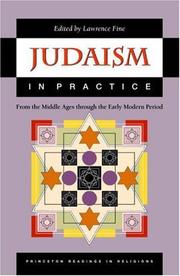
ISBN: 0691057877 0691057869 9780691057873 Year: 2001 Publisher: Princeton: Princeton university press,
Abstract | Keywords | Export | Availability | Bookmark
 Loading...
Loading...Choose an application
- Reference Manager
- EndNote
- RefWorks (Direct export to RefWorks)
Judaism --- Women in Judaism --- Jews --- History --- Sources --- Customs and practices --- Judaïsme --- Femmes dans le judaïsme --- Juifs --- Sources. --- Biography. --- Histoire --- Coutumes et pratiques --- Biographies --- Judaism - History - Medieval and early modern period, 425-1789 - Sources --- Judaism - Customs and practices - History - Sources. --- Women in Judaism - History - Sources. --- Jews - Biography.
Book
ISBN: 9782246859475 2246859476 Year: 2016 Publisher: Paris Bernard Grasset
Abstract | Keywords | Export | Availability | Bookmark
 Loading...
Loading...Choose an application
- Reference Manager
- EndNote
- RefWorks (Direct export to RefWorks)
Pourquoi les Juifs sont à jamais glorieux. Où est Ninive aujourd'hui - et que s'y passe-t-il vraiment ? Proust et le Zohar, Claudel et le livre d'Isaïe. Vivons-nous, ou non, le retour des années trente ? Pourquoi il n'est pas demandé de croire, mais de savoir. Lacan et la Kabbale. Ce qu'Auschwitz eut d'unique. Quand un talmudiste invente la langue française. Pourquoi l'antisionisme est le masque de l'antisémitisme de masse. Alexandre Kojève et le prophète Jonas. A quand un Talmud musulman ? Une conversation avec Romain Gary, une confidence de Michel Foucault. Partir ou rester ? Le sable contre la terre. Solal le fort et sa couronne de carton. Qu'est-ce qu'un "peuple élu" ? Quand Louis Althusser jetait les bases de la grande alliance judéo-catholique. Ce que veut dire "être juif". Itinéraire personnel, familial, intellectuel, d'un philosophe qui, trente-sept ans après Le testament de Dieu, donne L'esprit du judaïsme.
Judaism --- 296 --- 296 Judaisme --- 296 Judaïsme. Jodendom --- Judaisme --- Judaïsme. Jodendom --- Jewish life --- Jews --- Minhagim --- Commandments (Judaism) --- Religions --- Semites --- Philosophy. --- Customs and practices. --- Rites and ceremonies --- Religion --- Philosophy --- Customs and practices --- Identity --- Judaism - Philosophy --- Judaism - Customs and practices --- Jews - Identity --- Judaism - Apologetic works
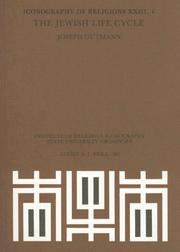
ISBN: 9004078924 9789004078925 Year: 1987 Volume: 4 Publisher: Leiden Brill
Abstract | Keywords | Export | Availability | Bookmark
 Loading...
Loading...Choose an application
- Reference Manager
- EndNote
- RefWorks (Direct export to RefWorks)
Iconography --- Jewish religion --- Judaism --- Jewish art and symbolism --- Customs and practices --- Pictorial works --- 296*5 --- -Jews --- Religions --- Semites --- Jews --- Jewish symbolism and art --- Jewish art --- Jewish arts --- Symbolism --- Symbolism in art --- Joodse godsdienst en liturgie --- -Pictorial works --- Religion --- Jewish art and symbolism. --- Pictorial works. --- -Joodse godsdienst en liturgie --- 296*5 Joodse godsdienst en liturgie --- -Jewish symbolism and art --- Customs and practices&delete& --- Judaïsme. Rites. Iconographie. --- Jodendom. Riten. Iconografie. --- Judaism - Customs and practices - Pictorial works
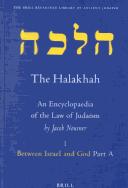
ISBN: 9004116176 9004116117 9004116125 9004116141 9004116168 9004494626 900449703X 9004497013 9004497021 9789004116160 9789004116146 9789004116122 9789004116177 9789004116115 9789004497030 9789004497016 9789004494626 9789004497023 Year: 2000 Volume: 1/I-V Publisher: Leiden; Boston : BRILL
Abstract | Keywords | Export | Availability | Bookmark
 Loading...
Loading...Choose an application
- Reference Manager
- EndNote
- RefWorks (Direct export to RefWorks)
The Halakhah embodies the complete Jewish Law, and contains commandments and guidelines for day-to-day living. The original commandments given by God to the Jewish people were enhanced by rabbis to offer a detailed framework to guide the lives of all Jews. In this complete, all-encompassing encyclopaedia of the Halakhah, the various laws are classified in such a way that a systematic and coherent structure is obtained. Each entry of the Halakhah is presented in a logical fashion. Where applicable, the original biblical wording is given, extended with literal abstracts from the Torah. Next, problems and questions that may arise from that law are stated and any additional information given. Finally, each entry gives comprehensive explanations and recommendations as to how these laws are to be observed in daily life - where to be and where not to be, what to do and what not to do, what to say and what not to say. The Halakhah, or standard Jewish Law, combines the Mishnah (about 200 CE), the Tosefta (about 300 CE), and the two Talmuds (about 400, 600 CE for the Land of Israel and Babylon, respectively). Volumes I and II contain entries pertaining to the Jewish people in relationship to God. Volume III explains how the Jewish people can restore and maintain their society in accordance with the Torah as it is explained by the rabbis. In Volumes IV and V of this study, we take up the life of the Jewish household in their encounter with God. The Encyclopaedic account therefore moves from regulating relationships between Israel and God to establishing stable and equitable relationships among Israelites and finally to actually living the Halakhah.
Jewish law --- Judaism --- 296*24 --- 296*24 Halacha --- Halacha --- Jews --- Religions --- Semites --- Biblical law --- Civil law (Jewish law) --- Halakha --- Halakhah --- Hebrew law --- Law, Hebrew --- Law, Jewish --- Law, Mosaic --- Law in the Bible --- Mosaic law --- Torah law --- Law, Semitic --- Commandments (Judaism) --- Customs and practices --- Religion --- Law --- Mishnah --- Tosefta --- Tosephta --- Thoseftha --- Mishna --- Mishnayot --- Mischnajot --- Mischna --- Mishne --- Michnah --- Mišnâh --- Mišna --- Mishnayoth --- Mishno --- Criticism, interpretation, etc. --- Jewish law - Encyclopedias --- Judaism - Customs and practices - Encyclopedias --- Shishah sidre Mishnah --- משנה --- ששה סדרי משנה --- משניות --- Jewish Law
| Listing 1 - 10 of 10 |
Sort by
|

 Search
Search Feedback
Feedback About UniCat
About UniCat  Help
Help News
News